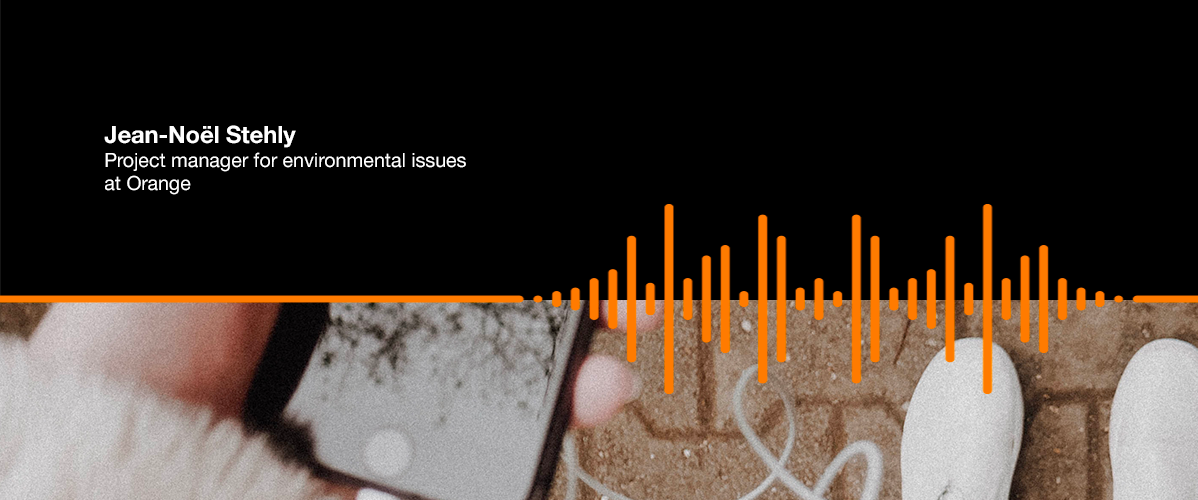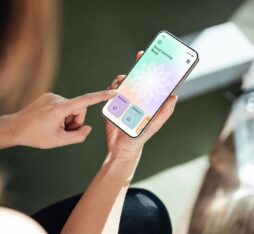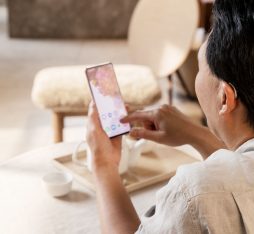Let’s use the Livebox 5 product as an example. From its design to its recycling, special care is taken from an environmental perspective, including recovering precious metals, using recycled plastic shells and incorporating simplified electronic architecture. Orange also ensures that the components to be recycled are recovered in the right channels and conducts regular studies to measure the equipment’s energy consumption, durability and reparability. Orange is also working on the knowledge of components, to make them more robust and consume less energy.
In terms of results, studies show that the Livebox 5, for example, emitted 30% less CO2 over its entire life cycle.
Jérôme Colombain:
Hi Jean-Noël.
Jean-Noël Stehly:
Hello.
JC:
You are Environmental Projects Manager within the Home Department at Orange. So, the environment, recycling, eco-design and so on — we know these are already longstanding issues. All carriers have been working on this for several years now. What about Orange?
JNS:
Well, we’ve been working on these matters for around fifteen years now. We’ve gradually developed skills and acquired a certain amount of knowledge in this area; we’ve worked with our suppliers and a number of partners on materials, on the consumption of equipment, and on its durability, including everything related to refurbishing, which makes it possible to reuse products for a longer period of time when customers bring them back to us, or to repair them. We’ve also looked into optimizing how equipment is used at the end of its lifecycle, with recycling and partners in the multiple countries where we operate.
JC:
Can you talk me through what happens if I return an Orange Livebox? What stages does it go through?
JNS:
The current process is that the Livebox is taken to one of our service providers. They test it to check whether it’s still working. If everything is in good working order, it will be put back in its original packaging and back into circulation. If repairs are needed, it will be refurbished with the parts, shell and everything it needs to work properly. Then, once again, it goes back into circulation.
JC:
Provided it’s not too old?
JNS:
Right, because then it would have to come off the market. Even so, each box stays in circulation for more than seven years on average. And it’s a lot of work. Approximately 5 million products are tested every year. Customers send them in, we test them, and the vast majority go back into circulation.
JC:
And what happens to the ones that don’t go back into circulation?
JNS:
They head to service providers, who then manage the recycling, dismantling and recovery of materials.
JC:
What can be recovered when they’re dismantled — precious metals, plastic, that kind of thing?
JNS:
Exactly. So the plastic goes into the plastic recycling channels. For metals, we try various smelting systems to extract the best raw materials that can later be reused in other products. But it’s not Orange who does that. Our job is to ensure that our products are recovered through the right channels.
JC:
OK, so before we get to recycling, there’s the design and eco-design part. The latest Livebox, which is still in circulation while we wait for the next one, was already very environmentally friendly. It was a genuine piece of eco-design, with a very high level of repairability and recycling. Tell us a little bit about it.
JNS:
Sure, the latest Livebox model, i.e. the Livebox 5, which is currently in circulation in France, had some major optimization work on materials, like you said, with the 100% recycled plastic shell. We also made it much simpler than the previous model. It was a fiber-only model, so simpler from an electronic architecture point of view, managing just one network connection.
JC:
There wasn’t any need for another device alongside.
JNS:
That’s right. And then, unlike the previous box, which allowed both fiber and ADSL access, this one was 100% fiber. So fewer materials, not so many connectors, and so on. Ultimately, as far as we were able to measure, it would generate 30% fewer CO2 emissions over its entire life cycle. So, yes, a significant improvement thanks to the different choices that we’d made and the various design stages the product had gone through.
JC:
And that’s the end of the journey – there’s been a progression over the years.
JNS:
Yes, that’s the end. We’re not there yet, but it’s another step all the same. For the past 15 years or so, a whole range of in-house experts have been working on eco-design, on materials, on knowledge of components—robust components, components with reduced consumption—packaging, transport, choice of suppliers, compliance with CSR standards and criteria, which we require from our suppliers, so buyers etc. There are eco-tech analyses that we can do on all the components to make sure we find the best strategies and options. It’s a wraparound approach to design, combining all of this in a product that’s consumer-friendly and easy to open, dismantle and repair. We’re talking about bringing together people with an extremely broad range of skills who can work on the hardware and the software. It’s a complex product.
JC:
I guess it’s all about compromise, isn’t it? Because we need a box that doesn’t consume too much and has all the qualities you’ve just mentioned. But at the same time, it needs to be attractive, functional, easy to use, and so on.
JNS:
Sure, eco-design is a compromise. It’s about trying to reduce environmental impact. And that in itself is a multi-faceted issue. There are different ways of measuring it. CO2 emissions is the one that immediately springs to mind. But it’s also the consumption of a whole series of materials, of non-renewable materials, of energy to produce the different components and then make the product run when it is connected.
Choosing to reduce the environmental impact therefore has more value in one aspect than another. And so we have to think about the possible options for the project. What makes the most sense at any given moment? And for this, there is a measurement tool called “life cycle analysis,” which really factors in all the product’s environmental externalities and measures whether the major impacts occur during manufacture, use or transport in relation to extracting resources or emitting CO2 or other types of pollution. This means it determines which actions have the most value.
For example, we were talking about compromise. Nowadays, you have to keep an electronic product cool. It mustn’t overheat. If you install a fan, it may make a little noise, make the product less robust; it’s something that can break more easily. But no fan means you need a bigger radiator, and that means more materials, more metals… you might consume less electricity but you’ve used more different metals to make a larger radiator. So determining what makes the most sense in terms of reducing impact is one of the things that need to be considered. And on a product such as a TV set-top box for example, we can now achieve very high performance in terms of power consumption thanks to very efficient standby modes. The more efficient the standby mode, the more likely it is that the product will take a little longer to turn back on, which then has an impact on user experience, having programs instantly on when the remote control is pressed. So it’s about finding the optimal compromise between the best environmental performance—in terms of power consumption—and keeping customers happy, from a product-responsiveness point of view.
JC:
Jean-Noël, when I use the TV remote to turn off my TV, why doesn’t it switch off my Livebox?
JNS:
Set-top boxes today are not controlled by the actual TV connection.
JC:
Except on some devices, right?
JNS:
No, that’s not a feature. And then, depending on the generation, there is a whole range of different set-top box/TV connections to manage. The statistics on the usage of our products show that, these days, there are many set-top boxes that seem to be turned on more than they should be given traditional viewing habits, which is a sign that customers tend to turn the television off but leave the set-top box switched on.
JC:
So this is a problem that you’ve identified.
JNS:
Right, so we need to make it known that we’ve done lots of things to ensure that the product is eco-designed and consumes less if it is put on standby. But if users are not in the habit of putting their products on standby, if they leave it switched on and just switch off the TV, we’ve missed out on an effective catalyst for reducing the overall impact of the TV service. And that means there is still room for improvement in our next generations of products.
JC:
So we can assume that you have to make compromises? We mentioned some trade-offs. Do you sometimes end up disappointed? Forced to accept that “this should be done, but in the end we just can’t”?
JNS:
For anyone focusing on environmental matters, it is both exciting, because there is a wealth of opportunities, but also frustrating, because we always want to go further. There are always ideas, strategies and options for doing more. Beyond that, it’s a question of time, costs, user impact — and these elements are not all simultaneously compatible. Today, you look at the entire life cycle of a product when you think, from a modeling point of view, what is going to be active on the market in one year, seven years’ time or more. In terms of CO2 emissions, two thirds of the impact of a Livebox is during its use, i.e. its consumption of electricity.
So you can see that we see still have plenty of ways in which we can work and optimize, albeit with the constraint that the Livebox is at the heart of a household’s digital life; you can’t just put it on standby at any time. But continually improving and therefore reducing overall power consumption, so that there is less environmental impact, means exploring a whole range of areas and enhancing these aspects in future products.
JC:
Thank you. That was Jean-Noël Stehly, Environmental Projects Manager at Orange.











